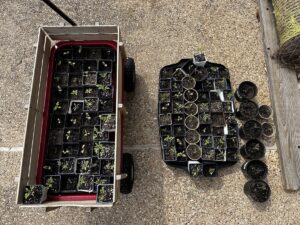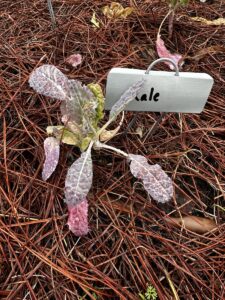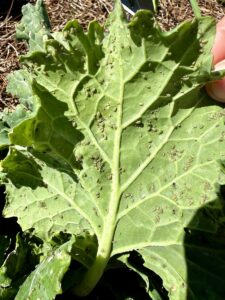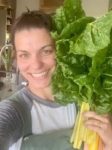The March Vegetable Garden Checklist by Paula Wolfel

Hardening off tomato and pepper seedlings in preparation for their mid-March transplant to the garden.
March is the month that Austin gardeners wait for all year. In much of Travis County, you can plant your vegetable garden in mid to late March. An important step before planting your garden is to prepare your soil for its new occupants. Also, this month, you can start hardening off seedlings that were grown indoors to gradually expose the tender plants to the wind and sun, and acclimate to outdoor conditions. Finally, although warm temperatures seem to be here to stay, continue to keep an eye on any temperatures that fall below 50 degrees and cover your plants for the duration of that “drop” in temperature.
Soil Preparation an Essential First Step
Know your soil and of do everything you can to make sure your plants live in the healthiest and best soil possible. I have seen gardens where every condition is near perfect but because no time and attention went towards soil preparation, the plants (and the gardener) suffered the entire growing season. One of the reasons for this is that plants feed themselves with nutrients found in the soil. If your soil is depleted of nutrients, then your plants are not receiving what they need to grow and produce food. Depletion can be due to the type of soil or because you are using soil that has been used in your garden throughout the last year and is therefore lacking nutrients that the previous plants used.
What nutrients are important to plants?

Kale leaves that should be green are purple likely due to Phosphorus deficiency in soil.
Nitrogen is a key ingredient for photosynthesis. It is important for good stem and leaf growth. If there is too much nitrogen in the soil, the plant will focus on growing leaves and neglect forming fruit.
Phosphorus is key for root development and seed formation, and increases water use efficiency and the movement of nutrients throughout the plant. It also aids in forming flowers and fruit. This nutrient enables a plant to convert sunlight to carbohydrates.
Potassium aids plants in temperature regulation and the movement of water, nutrients, and carbohydrates in plant tissue.
Test your soil every 3 years unless your soil-management practices change. Testing determines what nutrients your soil might be lacking. You can get that done through the AgriLife Extension Soil, Water, and Forage Testing Laboratory at Texas A&M University.
What about water?
Nutrients that are dissolved in water enter a plant through the roots and transports where needed through the plant.
Don’t forget Organic Material
A key to successful gardening in Texas is incorporating organic materials into the soil, always being mindful of their nutrient content. Organic material also affects a soil’s structure. Under favorable temperatures and moisture conditions, bacteria, earthworms, fungi, insects, and other organisms consume organic material and break it down into inorganic nutrients.
Decomposing organic material also improves the relationship between air and water in the soil. In sandy soils, organic material increases the soil’s water-holding capacity. And in clay soils, the organic material provides aeration for excess water to drain faster and oxygen to move into the soil more easily. Compost is the product that nature creates when it breaks down what once were living organisms and transforms them into a crumbly, dark-brown materials.
To add organic material to your soil, simply put 2-4 inches of organic material on the existing soil. With your hands or cultivating tool, work the organic material into approximately the top 8 inches of your soil. During the growing season you can add more compost as a top dressing where needed.
March Vegetable Garden Checklist
Here is the list of to-dos in the March vegetable garden.
FERTILIZE
- If the garden soil has not been tested, use 2 to 3 pounds of granular fertilizer for every 100 square feet of garden area. Spread the fertilizer evenly over the garden and mix with the soil to a depth of 3 to 4 inches before rows or beds are made. Alternatively, use a liquid fertilizer that is applied once the seedlings have at least two sets of true leaves. Read more about fertilizer application here.
WATER
- Monitor your soil moisture using a meter or by digging into the soil and feeling with your hands. Soil should feel moist but not wet.
- Irrigate newly transplanted plants every day for the first two weeks as needed. Depending on the weather (the high daily temperature, the amount of rain, and the strength of the sun on your garden) water every 2-3 days for the first 12-weeks.
PLANTING
Seeds
- Beets (all month)
- Carrots (early month)
- Radish (all month)
- Turnips (all month)
Transplants
- Eggplant (mid-late month)
- Peppers (late month)
- Tomatoes (all month but cover them if the temperature drops)
Seed or Transplants
- Beans, snap or lima (all month)
- Cantaloupe and Honeydew (mid-late month)
- Chard, Swiss (all month)
- Corn (all month)
- Cucumber (all month)
- Greens, cool season (early-mid month)
- Green, warm season (all month)
- Kohlrabi (early month)
- Lettuce (early month)
- Mustard (early- mid month)
- Peas, southern (late month)
- Pumpkin (all month)
- Squash, summer (all month)
- Squash, winter (all month)
- Watermelon (mid-late month)
SOIL
- Use mild days to turn compost and add organic material to your soil
- Keep soil covered with mulch even if the garden is empty to protect the nutrients in your soil and maintain soil moisture; once plants are in the soil, makes sure to use mulch but do not place mulch up against the stem of a plant
DISEASES/PESTS TO LOOK FOR

Aphid infestation on collards.
- Aphids are out already. But alongside the aphids, their predators have also been spotted. So when trying to rid your garden of the aphids, be mindful of the beneficial insects and their eggs and larvae:
- Lady Beetles (eggs are yellowish orange ovals that stand on end)
- Hover Flies (eggs look like grains of rice and larva look like maggots, slugs or worms)
- Parasitic Wasps (they lay their eggs in the aphids)
- Lacewings (have not seen in the garden yet.)
- Aphid Midge (have not seen in the garden yet)
- Damsel Bug (have not seen in the garden yet)
MAINTENANCE
- Check to make sure your irrigation system is ready for spring.
- Clean and sharpen your tools.
HARVEST
- Harvest the remaining brassicas (cauliflower, Brussel sprouts, cabbage, broccoli, kale) before the temperatures get too hot for them. Use them in salads and slaws accompanied with mango, avocado, and nuts for a springtime freshness; sauté with miso butter or olive oil and garlic; ferment them; or freeze them for soups and smoothies throughout the summer.
- Keep an eye on onions, garlic, carrots, beets, and radishes that were planted in the ground in late fall and will be ready for harvest within the next month or so.
Additional Resources
Weather Strategies for Austin Gardens
Watch the Vegetable Gardening in Central Texas Webinar
Vegetable Planting Calendar (Español, 繁体中文)
Recommended Vegetable Varieties for Travis County
Easy Gardening Series Detailed tips from Texas A&M University AgriLife Extension on specific crops and practices.
Vegetable Gardening in Austin Resource hub for all things vegetables for Travis County
Plant Rotations, Successions and Intercropping
Monthly Gardening Calendar for Austin and Central Texas
Sustainable Food Center Farmers Markets
About Paula Wolfel
 Paula Wolfel joined the Travis County Master Gardener program in 2022, but has been gardening in Austin, Texas since 2017. She grew up in the suburbs of Chicago learning how to garden from both her father—a Sicilian vegetable and fruit tree gardener—and both her grandmothers, and then spent years in Virginia gardening. Paula loves gardening because she finds it to be a grounding force- it gets her out of her head and into the present. She loves the pride that comes with cooking a meal for her family with every ingredient coming from her garden… and then the humility she feels when she loses an entire crop because of Mother Nature. She finds gardening to be wisdom, lessons, best practices passed down generation to generation, season to season and hopes to share that with you.
Paula Wolfel joined the Travis County Master Gardener program in 2022, but has been gardening in Austin, Texas since 2017. She grew up in the suburbs of Chicago learning how to garden from both her father—a Sicilian vegetable and fruit tree gardener—and both her grandmothers, and then spent years in Virginia gardening. Paula loves gardening because she finds it to be a grounding force- it gets her out of her head and into the present. She loves the pride that comes with cooking a meal for her family with every ingredient coming from her garden… and then the humility she feels when she loses an entire crop because of Mother Nature. She finds gardening to be wisdom, lessons, best practices passed down generation to generation, season to season and hopes to share that with you.

